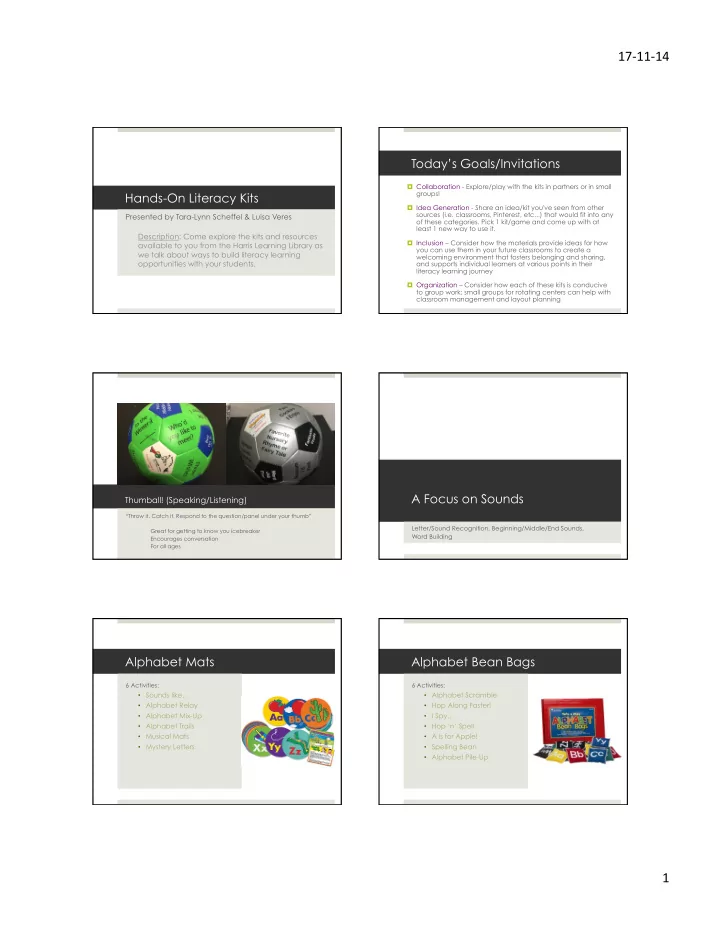

17-‑11-‑14 ¡ Today’s Goals/Invitations ¤ Collaboration - Explore/play with the kits in partners or in small groups! Hands-On Literacy Kits ¤ Idea Generation - Share an idea/kit you've seen from other sources (i.e. classrooms, Pinterest, etc...) that would fit into any Presented by Tara-Lynn Scheffel & Luisa Veres of these categories. Pick 1 kit/game and come up with at least 1 new way to use it. Description: Come explore the kits and resources ¤ Inclusion – Consider how the materials provide ideas for how available to you from the Harris Learning Library as you can use them in your future classrooms to create a we talk about ways to build literacy learning welcoming environment that fosters belonging and sharing, opportunities with your students. and supports individual learners at various points in their literacy learning journey ¤ Organization – Consider how each of these kits is conducive to group work; small groups for rotating centers can help with classroom management and layout planning A Focus on Sounds Thumball! (Speaking/Listening) “Throw it. Catch it. Respond to the question/panel under your thumb” Letter/Sound Recognition, Beginning/Middle/End Sounds, Great for getting to know you icebreaker Word Building Encourages conversation For all ages Alphabet Mats Alphabet Bean Bags 6 Activities: 6 Activities: • Sounds like… • Alphabet Scramble • Alphabet Relay • Hop Along Faster! • Alphabet Mix-Up • I Spy… • Alphabet Trails • Hop ‘n’ Spell • Musical Mats • A is for Apple! • Mystery Letters • Spelling Bean • Alphabet Pile-Up 1 ¡
17-‑11-‑14 ¡ Ending Sounds/Short Vowel Sounds Alphabet Bingo/Beginning Sounds Bingo 3-in-a-row game • Spin to choose an ending sound and then find the picture to match the selected sound Sound It Out Puzzles Beginning, Middle, Ending Sounds Match-Ups Puzzle pieces are self-correcting as Moving from single sound/letter learners find two images that have relationships to more difficult the same sounds (beginning, combinations middle or end) • Blends • Digraphs • Vowel Combinations A Focus on Vocabulary & Syntax Word-Building Interactive Word-Building Activities Create words by twisting, matching and threading • Sight Words, Sentence Building 2 ¡
17-‑11-‑14 ¡ Picture Words Bingo Sight Word Buckets Build vocabulary with a Activities: combination of pictures and words • practice building sentences on a whiteboard or cookie sheet • use on a magnetic word wall NounSense Board Game Make your own funny stories! • encourages reading • teaches about nouns • word recognition/matching Sentence-Building Interactive Sentence-Building Centers A Focus on Reading/Storytelling Big Books Great for Modelled and Shared Reading Large print allows you to explore letter-sound relationships, punctuation, • Big Books, Wordless Books, Puppet Theatre, Puppet Gloves, rhyming words, etc. Character Paddles Encourages discussion • • Supports retelling and role-playing 3 ¡
17-‑11-‑14 ¡ Wordless Books Puppet Theatre Making sense of visual information to support learners, ask deeper questions, gain insight into story, revisit key details, enhance comprehension Reasons for using puppets as a literacy tool: Can lead to a variety of response activities such as story mapping, sequencing, 1. “Using puppets for creative play inspires storytelling. As children writing the story that goes with the illustrations, etc. play together with puppets, they will naturally begin to use them to make up stories. Questions to ask when reading wordless books: 2. Using puppets will strengthen oral language skills, which we know • What do you think is happening here? (comprehension) plays an important role in learning to read. What makes you think that? (inferring) • 3. After listening to or reading stories, puppets can be used to retell stories. This practice helps strengthen comprehension skills.” • What do you think will happen next? (predicting) ~Michele Dufresne’s Teaching Tips, Literacy Consultant/Authorhttps://www.pioneervalleybooks.com/ • Why? (vocabulary and oral language) news/puppets-are-powerful-literacy-tools/ Source: http://www.pre-kpages.com/jim-trelease-wordless-picture-books/ Felt Creations Encouraging imagination Many story possibilities Teaching narrative elements Storytelling Glove, Lapboard & Apron Retelling stories (individual and collaborative) Before & After Early Literacy Match-Up Sequencing Events Analyzing Information Vocabulary Development Big Book Kits Includes wooden character paddles for retelling Rhyming activity cards Guide with cross-curricular teaching ideas 4 ¡
17-‑11-‑14 ¡ It Looked Like Spilt Milk (Big Book) -Book-Making Activity- Read “It Looked Like Spilt Milk” by Charles G. Shaw. Build on the familiarity of the patterning, work with students to model how they might make a class book that builds from the story or its concept. For example: Sometimes it looked like ________________________ But it wasn’t ____________________________ A Focus on Writing Have them also consider how you will bring your book to a similar conclusion: It was just a _____________________________ Provide materials to create pages as each student contributes to the making of a class book. Bookmaking, Writing Prompts, Venn Diagram Ideas Venn Diagram The Mysteries of Harris Burdick Activities: Compare and contrast two main • characters • 14 illustrations with a single caption each Explore the way two poets deal with a • similar subject matter – e.g. what is Opportunity to write the rest of • common, what is different? the story using the illustration and caption as a prompt • Collate information (e.g. use two separate nonfiction sources on a topic and find what is common to both – e.g. global warming) • Investigate commonly confused concepts – e.g. evaporation and condensation Explore a complex concept (e.g. • gender) using popular internet memes from two different eras • Source: Dreher & Gray (2009) References ¤ Dreher, M., & Gray, J. (2009). Compare, Contrast, Comprehend: Using Compare-Contrast Text Structures with ELLS in K-3 Classrooms. The Reading Teacher, 63(2), 132-141. ¤ See attached list for the literacy kits used in today’s session. 5 ¡
Recommend
More recommend